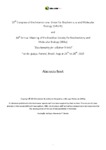Por favor, use este identificador para citar o enlazar este ítem:
http://www.alice.cnptia.embrapa.br/alice/handle/doc/1032260| Título: | Improving binding affinity prediction by using a rule-based model with physical-chemical and structural descriptors of the nano-environment for protein-ligand interactions. |
| Autor: | BORRO, L. C.  SALIM, J. A.   MAZONI, I.   YANO, I.   JARDINE, J. G.   NESHICH, G.   |
| Afiliación: | IB/Unicamp; FEEC/Unicamp; IVAN MAZONI, CNPTIA; INACIO HENRIQUE YANO, CNPTIA; JOSÉ GILBERTO JARDINE, CNPTIA; GORAN NESHICH, CNPTIA. |
| Año: | 2015 |
| Referencia: | In: CONGRESS OF THE INTERNATIONAL UNION FOR BIOCHEMISTRY AND MOLECULAR BIOLOGY, 23.; ANNUAL MEETING OF THE BRAZILIAN SOCIETY FOR BIOCHEMISTRY AND MOLECULAR BIOLOGY, 44., 2015, Foz do Iguaçu. Biochemistry for a better world: abstracts book. [Foz do Iguaçu]: SBBq, 2015. |
| Páginas: | p. 153. |
| Descripción: | In order to improve binding affinity prediction, we developed a new scoring function, named STINGSF, derived from physical-chemical and structural features that describe the protein-ligand interaction nano-environment of experimentally determined structures. |
| NAL Thesaurus: | Artificial intelligence |
| Palabras clave: | Interação proteína-ligante Aprendizado de máquina Inteligência artificial Protein-ligand interaction Scoring functions Machine learning |
| Notas: | C.047. |
| Tipo de Material: | Resumo em anais e proceedings |
| Acceso: | openAccess |
| Aparece en las colecciones: | Resumo em anais de congresso (CNPTIA)  |
Ficheros en este ítem:
| Fichero | Descripción | Tamaño | Formato | |
|---|---|---|---|---|
| ImprovingBorro.pdf | 120,45 kB | Adobe PDF |  Visualizar/Abrir |









